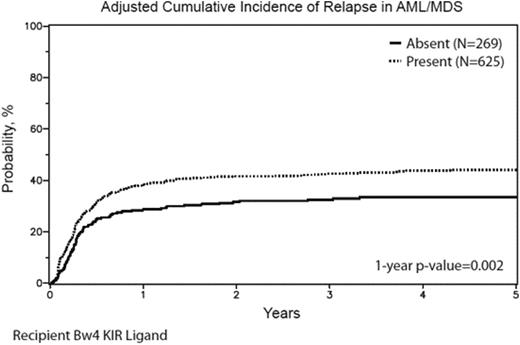Abstract
Disease relapse is a significant cause of treatment failure after allogeneic hematopoietic stem cell transplantation (HCT). In the setting of reduced-intensity conditioning (RIC), a graft-versus-leukemia (GVL) effect is critical for successful outcomes in patients with advanced myeloid malignancies. A GVL effect has been attributed in part to donor-derived alloreactive natural killer (NK) cells, which are regulated by interaction of KIRs with their HLA-class I ligands. Several models of NK reactivity (missing KIR ligand, centromeric haplotype-B content, non-tolerized KIR2DS1) have been associated with improved outcomes following HLA-matched, HLA-mismatched, related, and unrelated donor HCT, particularly for AML patients given myeloablative conditioning. The effect of KIR-HLA combinations on outcomes after RIC HCT, however, is not known. We retrospectively analyzed donor-recipient KIR/HLA genotypes from 929 URD HCTs facilitated by the National Marrow Donor Program for patients with AML (n=624) or MDS (n=305) treated with RIC between 1990 and 2007. 664 donor-recipient pairs were 10/10 HLA-matched and 265 were 9/10 HLA-matched. 332 (37%) patients received ATG and 73 (8%) received alemtuzumab. P-values less than 0.01 were considered significant. We hypothesized that donor-recipient KIR-HLA interactions may be associated with improved post-transplant outcomes following RIC HCT for AML and MDS. Patients lacking the HLA-Bw4 ligand for donor inhibitory KIR3DL1 experienced lower relapse following HCT at 1 year (27 vs 36%, p=0.002) and 5 years (31 vs 42%, p=0.003) compared to patients with the Bw4 ligand (Figure). The lower risk for relapse was confirmed in multivariate analysis (HR 0.71, p=0.005). However, there was no significant association of Bw4 ligand with disease-free survival (HR 0.84, p=0.05) and overall survival (HR=0.97, p=0.70). Risk for acute GVHD was higher among patients lacking KIR ligands after adjusting for other clinical factors. In particular, patients lacking HLA-C2 for donor KIR2DL1 experienced higher grade 2-4 (HR 1.3, p=0.005) and 3-4 acute GVHD (HR 1.5, p=0.002), and patients lacking multiple KIR ligands experienced higher grade 3-4 acute GVHD (HR 1.5, p=0.007). The analysis was then restricted to AML patients, the patient population with greatest reported KIR-HLA effects. Patients whose donors were KIR2DS1+ and HLA-C2C2 (n=33) had higher transplant-related mortality (TRM) (HR, 2.4, p=0.002) compared to all other patients. There was no significant effect of KIR2DS1 with HLA on relapse. In a multivariate analysis, lack of HLA-C2 in AML patients was associated with higher grade 2-4 (HR 1.4, p=0.002) and 3-4 acute GVHD (HR 1.5, p=0.01), and risk for grade 3-4 acute GVHD was higher in patients lacking multiple KIR ligands (HR 1.6, p=0.005). There were no significant associations between donor homozygosity for the centromeric B-haplotype (cenBB) or overall B-haplotype KIR content and RIC HCT outcomes.
No relevant conflicts of interest to declare.
Author notes
Asterisk with author names denotes non-ASH members.


This feature is available to Subscribers Only
Sign In or Create an Account Close Modal